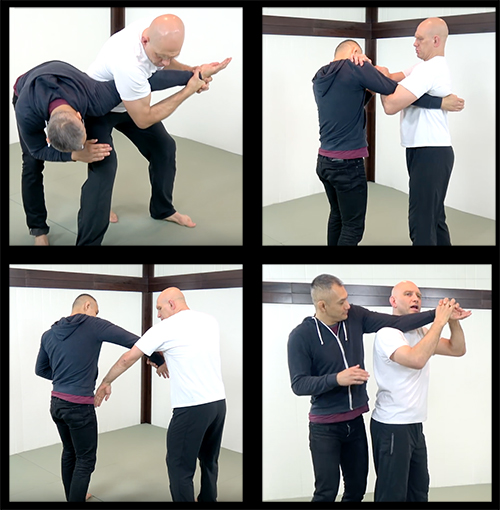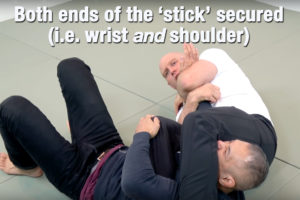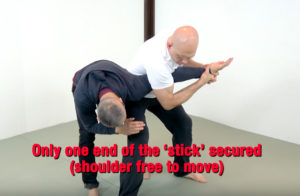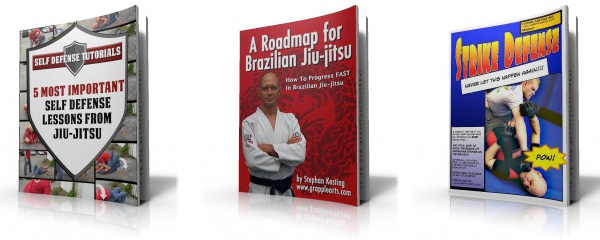Standing armlocks are a staple in the martial arts, including Aikido, classical ju-jujutsu, and many modern self defense systems.
They’re usually practised something like this: your partner comes in with a lunging punch, you block and sidestep, control the arm, step in, and then apply pressure to the arm until he taps out.
Here’s what some of those standing armbars from those different systems might look like…
These might look very nice when you’re practising them against a compliant training partner who isn’t fighting you tooth and nail.
But the trouble is, that in reality, this sort of armlock application is mostly fantasy.
Standing armlocks are not submission holds and are not restraints. Properly executed they are almost always actually joint breaks and are very difficult to incorporate into your sparring and to become proficient in without damaging your training partners.
Here’s the original video from my Self Defense Tutorials Youtube channel in which I started talking about some of the problems with standing armlocks…
There are two main problems when it comes to standing armlocks…
STANDING ARMLOCK PROBLEM #1: LACK OF CONTROL
Oleg Taktarov, Sambo practitioner and UFC 6 tournament champion, once described a joint lock as ‘breaking a stick.‘
He said that if you’re camping and you want to break a stick for firewood, you grab both ends of the stick, put your knee against the middle of it, and push. Snap!
This analogy works great if you’re doing a classic straight armbar on the ground…
With this style of armbar your hands control one of of the ‘stick’ (his wrists), your legs control the other end (his head and shoulders), and then your hips apply pressure against the middle of the stick (his elbow). Your body then works together to snap the lever of his arm over the fulcrum of your hips to get the submission or to break his arm.
But if we control only one end of the stick and try breaking it over our knee then it becomes much more difficult. And that’s exactly what most classical standing armlocks are like…
In a standing armlock you typically control his wrist or hand, and apply the pressure to the elbow with your armpit, ribs or shoulder (as covered in the video at the top of the article), but there’s nothing keeping his head and shoulder in place.
With a standing armlock you’re NOT controlling both ends of the stick, and that means that – most of the time – a determined opponent will find a way to twist out of the submission and escape.
If you’ve ever tried to apply standing armlocks as a finishing hold in Judo, MMA or submission grappling practise you’ll have learned that they’re really, really difficult to apply against a resisting opponent.
Unless there’s a huge size and/or skill discrepancy your opponent will almost always find a way to wiggle out of your standing armlock?
Why is this? Lack of control over the shoulder!
To apply the standing armlock in real life you have to rely on speed. You have to apply it so fast and so suddenly that the weight of his body provides a sufficient anchor point for his arm to create the joint lock effect on the elbow.
By doing this type of lock fast you’re no longer using the armlock as a restraint or a submission. You’ve moved into arm breaking and elbow wrenching territory, where the intent is to actually damage the arm and disable your opponent.
While this wrenching approach can certainly work (we’ll look at some successful examples of it later in this article) it does make it very difficult to train in sparring.
Which brings us to our next problem…
STANDING ARMLOCK PROBLEM #2: DANGEROUS AND DIFFICULT TO TRAIN IN SPARRING
So we’ve established that standing armlocks, when they work, are usually swiftly applied arm breaks and not restraining or bargaining positions.
But how do you actually train them then?
To think that you can drill a technique in kata form 1000 times and then have it magically work in a real life situation is a terrible strategy, and almost always ends in disaster.
Without sparring there are no miracles, and the idea that you’re too deadly to spar almost always leads to disaster in a real confrontation.
Countless theoretically deadly martial artists have had their asses handed to them when they went up against a resisting opponents (this Kiai Master vs MMA video is a famous example of this delusion but there are many more).
To develop a technique and make reliable under pressure you need to test it and develop it in sparring.
You really need to trying to do that technique against someone who is really trying to get out of it and visa versa!
If you want to incorporate these standing arm break type movements into your repertoiret my suggestion would be to first get really good at ‘normal’ standup grappling with a heavy focus on the gripfighting and clinching you’d see in Judo, Greco-Roman and Freestyle wrestling.
First of all, this range is eminently sparrable, and fighting in this range without the you comfortable in the chaos of a standup grappling situation. You’ll learn how to remain on your feet, off balance your opponent, take him down, defend against his attacks, and fight for your own strikes and takedowsn.
All of the above can be trained in a moderate-to-full resistance scenario without too much danger of permanent joint damage.
Then, once you’re comfortable in the standup grappling range, you can start drilling the occasional ‘illegal’ technique with a compliant partner at half speed.
If you ever get into a real confrontation then your skills in the standup arena developed by all that regular, normal, legal grappling should might just allow you to stay on your feet long enough to apply that unorthodox, illegal, elbow wrench that you’ve always dreamed about.
EXAMPLES OF REAL WORLD STANDING ARMLOCKS
OK, so I’ve been insisting that standing armlocks that result in a controlled submission are very, very rare.
And that when they get applied in reality they usually end up being elbow wrenches and breaks.
Let’s look at a few examples of these types of arm wrenches being applied in different situations…
Ben Skijkers’s Waki Gatame in Judo
Ben Spijkers is a tough three time Judo Olympian who also fought in early MMA against both Erik Paulson and Renzo Gracie.
In the clip below his opponent (in white) reaches forwards with his right hand to grab Spijkers’s left lapel. Spijkers secures the wrist and the elbow and then turns sharply, slamming his ribs into his opponent’s straight arm, hyperextending the elbow and crumpling his opponent to the ground.
Shinya Aoki Standing Arm Wrench in MMA
Shinya Aoki is a very talented MMA fighter who has broken more than one opponent’s arm. In this 2005 Shooto match in Japan he converts an underhook into a whole body elbow wrench that clearly damages the arm of his unfortunate opponent to end the fight.
Elbow Wrench in No Gi Grappling
I don’t know anything about the details here other than that I feel sorry for the recipient. This only worked because the perpetrator was much bigger and stronger than his opponent.
Midair Uchimata to Waki Gatame Conversion
In this clip below the Judo competitor in blue attacks with an Uchimata throw which lifts his opponent (in white) high off the ground.
While his opponent is still in the air blue switches to a wake gatame armlock and slams his opponent face first into the mat with it, clearly with an intent to damage the arm.
It was an illegal Judo technique, and is all but impossible to practice at competition intensity in the training hall. But it was years and years of becoming comfortable and familiar with the mechanics of hoisting someone into the air that allowed the Judoka to make this adaptation on the fly.
Other Joint Lock Options on the Feet
This article was about the standing straight armlock, but that’s not the only submission that works on the feet.
The Standing Kimura is probably the most effective and reliable standing armlock.
In part this is because you do have some control over both ends of the lever: your hands control his wrist and your armpit clamps down on his shoulder, allowing you to isolate the arm somewhat. Also the Kimura grip creates a very strong handle that can give you enough control to set up several different sacrifice throws.
This move became infamous after Kazushi Sakuraba used it to break Renzo Gracie’s arm during a match in Japan (Pride 10, Return of the Warriors) back in 2000.
Here’s a breakdown of how to do the Standing Kimura from my Grapplearts Youtube channel.
There are also some wrist locks that work on the feet, and they can be included in sparring, but they generally require you to have a significant skill and/or hand strength advantage over your opponent.
And finally we have to at least mention the standing versions of Guillotine Choke (the first submission covered in this article here) and the Rear Naked Choke (arguably the most important submission in self defense) which have proven to be effective fight-enders in many MMA fights.
More Self Defense Tips
If you’re a first time visitor to this site and have read this far down the article then you’re likely interested in self defense.
You might have enjoyed this article, and might want to read more on this site sometime. The reality is the internet is a very big place and if you click away you might never come back.
There’s one way to make sure that you keep up with new articles, videos, tips, tricks, and techniques…
And that’s by signing up for my 100% free self defense tips email newsletter.
Enter your best email in the box below to stay up to date with what’s being added to this site:
Get My FREE Self Defense Tips by Email
The newsletter itself will give you some of our very best self defense tips, techniques and training methods. It’s 100% free, always will be, and is very easy to unsubscribe from if you don’t like what you get.
If you’re interested in realistic martial arts training and self defense then you really should check it out. I get nothing but great feedback about it all the time.
Click here to find out more about this newsletter and download these 3 books for free!
Sincerely
Stephan Kesting



